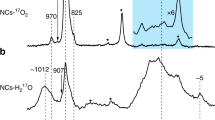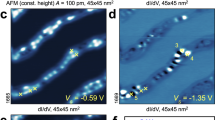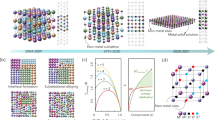Abstract
Surface structure controls the physical and chemical response of materials. Surface polar terminations are appealing because of their unusual properties but they are intrinsically unstable. Several mechanisms, namely metallization, adsorption, and ordered reconstructions, can remove thermodynamic penalties rendering polar surfaces partially stable. Here, for CeO2(100), we report a complementary stabilization mechanism based on surface disorder that has been unravelled through theoretical simulations that: account for surface energies and configurational entropies; show the importance of the ion distribution degeneracy; and identify low diffusion barriers between conformations that ensure equilibration. Disordered configurations in oxides might also be further stabilized by preferential adsorption of water. The entropic stabilization term will appear for surfaces with a high number of empty sites, typically achieved when removing part of the ions in a polar termination to make the layer charge zero. Assessing the impact of surface disorder when establishing new structure–activity relationships remains a challenge.
This is a preview of subscription content, access via your institution
Access options
Subscribe to this journal
Receive 12 print issues and online access
$259.00 per year
only $21.58 per issue
Buy this article
- Purchase on Springer Link
- Instant access to full article PDF
Prices may be subject to local taxes which are calculated during checkout





Similar content being viewed by others
References
Wu, Z. & Overbury, S. H. Catalysis by Materials with Well-Defined Structures (Elsevier, 2015).
Nørskov, J. K., Bligaard, T., Rossmeisl, J. & Christensen, C. H. Towards the computational design of solid catalysts. Nat. Chem. 1, 37–46 (2009).
Calle-Vallejo, F., Loffreda, D., Koper, M. T. M. & Sautet, P. Introducing structural sensitivity into adsorption–energy scaling relations by means of coordination numbers. Nat. Chem. 7, 403–410 (2015).
Sun, Y. & Xia, Y. Shape-controlled synthesis of gold and silver nanoparticles. Science 298, 2176–2179 (2002).
Xia, X. et al. On the role of surface diffusion in determining the shape or morphology of noble-metal nanocrystals. Proc. Natl Acad. Sci. USA 110, 6669–6673 (2013).
Lu, M. et al. Shape-controlled synthesis of hybrid nanomaterials via three-dimensional hydrodynamic focusing. ACS Nano 8, 10026–10034 (2014).
Xia, Y., Xiong, Y., Lim, B. & Skrabalak, S. E. Shape-controlled synthesis of metal nanocrystals: simple chemistry meets complex physics? Angew. Chem. Int. Ed. 48, 60–103 (2009).
Wei, Z. & Matsui, H. Rational strategy for shaped nanomaterial synthesis in reverse micelle reactors. Nat. Commun. 5, 3870 (2014).
Helmi, S., Ziegler, C., Kauert, D. J. & Seidel, R. Shape-controlled synthesis of gold nanostructures using DNA origami molds. Nano Lett. 14, 6693–6698 (2014).
Tasker, P. W. The stability of ionic crystal surfaces. J. Phys. C Solid State Phys. 12, 4977–4984 (1979).
Noguera, C. & Goniakowski, J. Polarity in oxide nano-objects. Chem. Rev. 113, 4073–4105 (2013).
Łodziana, Z., Topsøe, N.-Y. & Nørskov, J. K. A negative surface energy for alumina. Nat. Mater. 3, 289–293 (2004).
Lauritsen, J. V. et al. Stabilization principles for polar surfaces of ZnO. ACS Nano 5, 5987–5994 (2011).
Goniakowski, J. & Noguera, C. Characteristics of Pd deposition on the MgO(111) surface. Phys. Rev. B 60, 16120–16128 (1999).
Fonin, M. et al. Surface electronic structure of the Fe3O4 (100): evidence of a half-metal to metal transition. Phys. Rev. B 72, 104436 (2005).
Bliem, R. et al. Subsurface cation vacancy stabilization of the magnetite (001) surface. Science 346, 1215–1218 (2014).
Dulub, O., Diebold, U. & Kresse, G. Novel stabilization mechanism on polar surfaces: ZnO(0001)-Zn. Phys. Rev. Lett. 90, 016102 (2003).
Barbier, A. et al. Atomic structure of the polar NiO(111)-p(2 × 2) surface. Phys. Rev. Lett. 84, 2897–2900 (2000).
Enterkin, J. A. et al. A homologous series of structures on the surface of SrTiO3(110). Nat. Mater. 9, 245–248 (2010).
Erdman, N. et al. The structure and chemistry of the TiO2-rich surface of SrTiO3 (001). Nature 419, 55–58 (2002).
Kienzle, D. M., Becerra-Toledo, A. E. & Marks, L. D. Vacant-site octahedral tilings on SrTiO3 (001), the (13 × 13) R 33.7° surface, and related structures. Phys. Rev. Lett. 106, 176102 (2011).
Kirkpatrick, T. R. & Wolynes, P. G. Stable and metastable states in mean-field Potts and structural glasses. Phys. Rev. B 36, 8552–8564 (1987).
Marks, L. D., Chiaramonti, A. N., Rahman, S. U. & Castell, M. R. Transition from order to configurational disorder for surface reconstructions on SrTiO3(111). Phys. Rev. Lett. 114, 226101 (2015).
Herman, G. S. Surface structure determination of CeO2 (001) by angle-resolved mass spectroscopy of recoiled ions. Phys. Rev. B 59, 14899–14902 (1999).
Kim, Y. J. et al. Growth and structure of epitaxial CeO2 by oxygen-plasma-assisted molecular beam epitaxy. J. Vac. Sci. Technol. 17, 926–935 (1999).
Nörenberg, H. & Harding, J. H. The surface structure of CeO2(001) single crystals studied by elevated temperature STM. Surf. Sci. 477, 17–24 (2001).
Solovyov, V. F. et al. Highly efficient solid state catalysis by reconstructed (001) ceria surface. Sci. Rep. 4, 4627 (2014).
Qiao, Z.-A., Wu, Z. & Dai, S. Shape-controlled ceria-based nanostructures for catalysis applications. ChemSusChem 6, 1821–1833 (2013).
Vilé, G., Colussi, S., Krumeich, F., Trovarelli, A. & Pérez-Ramírez, J. Opposite face sensitivity of CeO2 in hydrogenation and oxidation catalysis. Angew. Chem. Int. Ed. 53, 12069–12072 (2014).
Agarwal, S., Mojet, B. L., Lefferts, L. & Datye, A. K. Catalysis by Materials with Well-Defined Structures 31–70 (Elsevier, 2015).
Mann, A. K. P., Wu, Z. & Overbury, S. H. Catalysis by Materials with Well-Defined Structures 71–97 (Elsevier, 2015).
Lin, Y., Wu, Z., Wen, J., Poeppelmeier, K. R. & Marks, L. D. Imaging the atomic surface structures of CeO2 nanoparticles. Nano Lett. 14, 191–196 (2014).
Pan, Y. et al. Ceria nanocrystals exposing wide (100) facets: structure and polarity compensation. Adv. Mater. Interfaces 1, 1400404 (2014).
Baudin, M., Wójcik, M. & Hermansson, K. Dynamics, structure and energetics of the (111), (011) and (001) surfaces of ceria. Surf. Sci. 468, 51–61 (2000).
Möbus, G. et al. Dynamics of polar surfaces on ceria nanoparticles observed in situ with single-atom resolution. Adv. Funct. Mater. 21, 1971–1976 (2011).
Bhatta, U. M. et al. Cationic surface reconstructions on cerium oxide nanocrystals: an aberration-corrected HRTEM study. ACS Nano 6, 421–430 (2012).
Dholabhai, P. P., Adams, J. B., Crozier, P. & Sharma, R. Oxygen vacancy migration in ceria and Pr-doped ceria: a DFT + U study. J. Chem. Phys. 132, 94104 (2010).
Grau-Crespo, R., Hamad, S., Catlow, C. R. A. & de Leeuw, N. H. Symmetry-adapted configurational modelling of fractional site occupancy in solids. J. Phys. Condens. Matter 19, 256201 (2007).
Lejaeghere, K. et al. Reproducibility in density functional theory calculations of solids. Science 351, aad3000 (2016).
Li, S.-C., Losovyj, Y., Paliwal, V. K. & Diebold, U. Photoemission study of azobenzene and aniline adsorbed on TiO2 anatase (101) and rutile (110) surfaces. J. Phys. Chem. C 115, 10173–10179 (2011).
Łodziana, Z., Nørskov, J. K. & Stoltze, P. The stability of the hydroxylated (0001) surface of α-Al2O3 . J. Chem. Phys. 118, 11179–11188 (2003).
Mullins, D. R. The surface chemistry of cerium oxide. Surf. Sci. Rep. 70, 42–85 (2015).
Gattinoni, C. & Michaelides, A. Atomistic details of oxide surfaces and surface oxidation: the example of copper and its oxides. Surf. Sci. Rep. 70, 424–447 (2015).
Gludovatz, B. et al. A fracture-resistant high-entropy alloy for cryogenic applications. Science 345, 1153–1158 (2014).
Butler, K. T., Walsh, A., Cheetham, A. K. & Kieslich, G. Organised chaos: entropy in hybrid inorganic–organic systems and other materials. Chem. Sci. 7, 6316–6324 (2016).
Załuska-Kotur, M. A. The kinetic Potts model in the description of surface dynamics. Surf. Sci. 265, 196–208 (1992).
Kresse, G. Efficient iterative schemes for ab initio total-energy calculations using a plane-wave basis set. Phys. Rev. B 54, 11169–11186 (1996).
Kresse, G. & Furthmüller, J. Efficiency of ab-initio total energy calculations for metals and semiconductors using a plane-wave basis set. Comput. Mater. Sci. 6, 15–50 (1996).
Perdew, J. P., Burke, K. & Ernzerhof, M. Generalized gradient approximation made simple. Phys. Rev. Lett. 77, 3865–3868 (1996).
Krukau, A. V., Vydrov, O. A., Izmaylov, A. F. & Scuseria, G. E. Influence of the exchange screening parameter on the performance of screened hybrid functionals. J. Chem. Phys. 125, 224106 (2006).
Dudarev, S. L., Savrasov, S. Y., Humphreys, C. J. & Sutton, A. P. Electron-energy-loss spectra and the structural stability of nickel oxide: an LSDA + U study. Phys. Rev. B 57, 1505–1509 (1998).
Fabris, S., de Gironcoli, S., Baroni, S., Vicario, G. & Balducci, G. Reply to “Comment on ‘Taming multiple valency with density functionals: a case study of defective ceria’”. Phys. Rev. B 72, 237102 (2005).
Blöchl, P. E. Projector augmented-wave method. Phys. Rev. B 50, 17953–17979 (1994).
Henkelman, G., Uberuaga, B. P. & Jónsson, H. A climbing image nudged elastic band method for finding saddle points and minimum energy paths. J. Chem. Phys. 113, 9901–9904 (2000).
Kümmerle, E. & Heger, G. The structures of C–Ce2O3+δ, Ce7O12, and Ce11O20 . J. Solid State Chem. 147, 485–500 (1999).
Nosé, S. A molecular dynamics method for simulations in the canonical ensemble. Mol. Phys. 52, 255–268 (1984).
Hoover, W. Canonical dynamics: equilibrium phase-space distributions. Phys. Rev. A 31, 1695–1697 (1985).
Tersoff, J. & Hamann, D. R. Theory and application for the scanning tunneling microscope. Phys. Rev. Lett. 50, 1998–2001 (1983).
Álvarez-Moreno, M. et al. Managing the computational chemistry big data problem: the ioChem-BD platform. J. Chem. Inf. Model. 55, 95–103 (2015).
Acknowledgements
This research has been supported by the ERC Starting Grant and Proof of Concepts (ERC-2010-StG-258406, ERC-2015-PoC_680900), the Ministerio de Economía y Competitividad—MINECO (CTQ2015-68770-R), and the Generalitat de Catalunya—AGAUR (SGR-2014-SGR-145). M.C.-C. acknowledges MINECO for a ‘Juan de la Cierva—Formación’ fellowship (FJCI-2014-20568). We acknowledge BSC-RES and CSUC for providing generous computational resources. We thank R. Grau-Crespo (University of Reading) for kindly providing us with the SOD software and A. Selloni (Princeton University) for critically reading the manuscript.
Author information
Authors and Affiliations
Contributions
M.C.-C. performed the calculations. M.C.-C. and N.L. analysed the data and prepared the manuscript.
Corresponding authors
Ethics declarations
Competing interests
The authors declare no competing financial interests.
Supplementary information
Supplementary Information
Supplementary Information (PDF 11121 kb)
Rights and permissions
About this article
Cite this article
Capdevila-Cortada, M., López, N. Entropic contributions enhance polarity compensation for CeO2(100) surfaces. Nature Mater 16, 328–334 (2017). https://doi.org/10.1038/nmat4804
Received:
Accepted:
Published:
Issue Date:
DOI: https://doi.org/10.1038/nmat4804
This article is cited by
-
Data-driven models for ground and excited states for Single Atoms on Ceria
npj Computational Materials (2022)
-
Vacancy driven surface disorder catalyzes anisotropic evaporation of ZnO (0001) polar surface
Nature Communications (2022)
-
Accelerated discovery of superoxide-dismutase nanozymes via high-throughput computational screening
Nature Communications (2021)
-
Self-adaptive dual-metal-site pairs in metal-organic frameworks for selective CO2 photoreduction to CH4
Nature Catalysis (2021)
-
Polar surface structure of oxide nanocrystals revealed with solid-state NMR spectroscopy
Nature Communications (2019)



